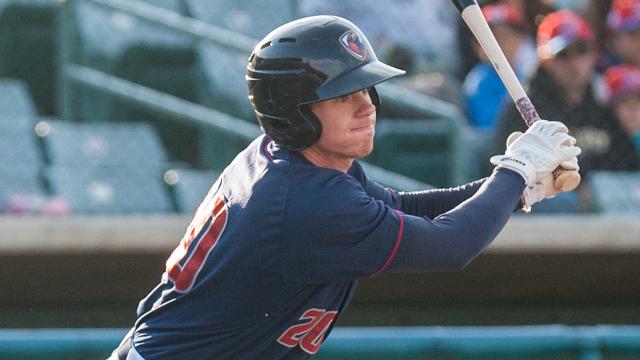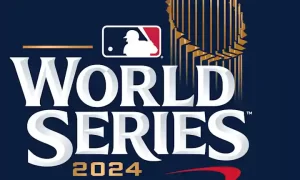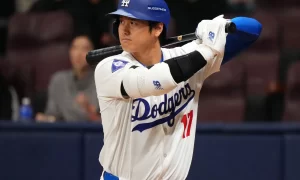In my senior year of high school, my baseball team went on an extraordinary run to finish as the runner-up in the state. We set a school record in wins and rattled off something like 25 straight before losing the Championship game. We persevered through a number of injuries, squabbles with the head coach, and were without three of our most talented players for the entire year as one blew out his elbow, while the other two opted to focus on football.
We got where we did through solid performances from surprising sources, like little Drew Ferguson who plugged in at second base and wasn’t a liability. One might even say he was good. I’m not sure what his expectations were for the year, but smoking a game winning double to score yours truly in the state quarterfinal was not within my realm of possibilities for Drew.
Fastforward 7 years and Drew is coming off a season that has him looking for playing time in Puerto Rican winter leagues. Ferguson’s 2016 season has led Astros Future to include him in a poll on the Astros Minor League MVP discussion. His stat line is eye-popping. Across High-A and AA, he played in 105 G, while hitting .315 BA/.408 OBP/.542 SLG, with 29 2B, 17 HR, and 30 steals.
I caught up with Drew last Friday and had an interesting conversation that covered his story, his approach to baseball, life in the Astros organization, and life in general. Below are a few of the highlights.
Sean: I went and played in college and I knew the whole time that I was never going to make the Majors. When did you figure out that “I might actually have a chance at making this a career?”
Drew: “I would say that there are definitely two main points in my playing career that stick out as far as that is concerned. I was like a lot of guys in high school. I had a good high school career, but I was just fortunate to walk on at Belmont. It was a pipe dream for me to play in Division 1 and I kind of lucked into my spot. I gradually developed at Belmont and got better and better.
After my junior season, I got a fair amount of interest from scouts after a good year overall. Getting drafted at that point had again been another pipe dream. It was never really an option; especially at a small D1 like Belmont, it [getting drafted] doesn’t really happen. But after speaking with scouts, I thought ‘I still have a little room to improve and maybe I can continue playing and play professionally.’ I went on and had a good senior season and was drafted by the Astros, but even then [it didn’t seem like a career].
The second time I was going to talk about was this season. Even once you get drafted, the players are much better and the atmosphere is very cutthroat. If you don’t perform, you can be out of pro ball in half of a season. I played pretty well my first season, but this season, I came into my own a little bit. I became a lot more comfortable with the quality of players that I was playing against and made the necessary improvements in my game to not only stick around, but give myself a chance to climb the ladder.
I have had a lot of help within the Astros organization. I think it’s a perfect fit for me, really. As far as developping players, I think they are up there. I am happy that I landed with them and happy that I have been able to make some strides, so far.”
Sean: I didn’t realize that you walked-on at Belmont. But I had read something that the Astros made an app for players to track their workouts on their phones. Am I making that up or do you have an app that tells you how to work out?
Drew: “There’s actually two different apps. One is a strength and condition program. It’s something to have on your phone to look at your workouts and track progress, and the Astros can update your workout plan.
The other app is actually the really interesting one and it aligns with the Astros organizational philosophy. The Astros are really big about strike zone discipline. They think that is one of the most valuable skills in baseball. It sounds simple: swing at good pitches, take the bad ones. Obviously, that’s really hard when you have people throwing really hard with really good offspeed pitches, etc. They have this app that they have created that takes pitch f/x data to track every pitch of every game to tell you pitch speed, spin rates, location, exit speed off the bat. It’s all the information that you can gather from each pitch. It then scores you based on a scoring system that they have designed. You get points for taking balls and swinging at strikes. And you lose points for taking strikes and swinging at balls.
It also takes into consideration the count. For example, the points are lesser in an 0-0 count versus a 3-2 count. In a 3-2 count, that’s important. Something is likely to happen there, whereas in 0-0 its’s not at important.”
Sean: I don’t know if you have read any of our blog, but I get pretty into pitch f/x data with spin rates, exit velocities, etc. Within that app, let’s say you pull a Vladimir Guerrero and hit a ball that bounces. Does it count against you?
Drew: “It has nothing to do with outcome [of the at bat]. This app is literally called the ‘Swing Decision App.’ It’s only there to help you develop good swing decisions. Now, they are not going to get onto you for hitting a homerun on a ball, but they do want you to develop the skill set needed to aggressively attack strikes and take balls because they think that is of the utmost importance for your development.
Sean: That’s actually really interesting. The last time we played together, you were a small second baseman.
Drew: That’s right.
Sean: Well, what are you now? Describe your style of play and why you’re being successful.
Drew: “I am definitely a different player now than I was in high school. I have grown into my body a little bit, but I am by no means a big player. I am about 5’11, 185. I moved to outfield in college, played center at Belmont. In pro ball, they have moved me around to all 3 outfield positions, but primarily in the corners. They stuck me in the corner because they don’t see me playing centerfield at the big league level. As a result, I have had to focus on certain mechanical aspects of my swing, to develop my swing. I have made certain changes in my swing to help drive the ball more….. Right now, to describe my style of play is a little bit of everything.
I am not going to hit the ball 500 feet, but I will hit a few home runs because I am focusing on barrelling everything up. I will draw my walks because I am trying to swing at good pitches. I am not going to get overly aggressive. [On the bases] I really [buy into] the importance of not making outs. I steal some bases. I know what I am doing on the basepaths. Less [about] stealing with pure speed and more [about] focusing on taking free bases when they don’t hold me correctly. I will take it every time in that situation.”
Sean: I read your interview with Astros Future where you talked about not getting caught.
Drew: “Yeah, I think the exact breakeven number is somewhere around 75% success. That’s not to say that there aren’t certain situations where you aren’t trying to take a chance. If it’s late in the game and you have a singles hitter behind you, then you can take a chance. But over the course of a season, you want to steal at a really high [success] rate.”
Sean: I read an interesting piece on Rickey Henderson‘s 130 steal season and how it may have not really helped his team all that much. The author went on to say that there is no true way to measure his impact because of how his presence affected pitcher psyche. Still, that idea of being caught stealing as a huge detriment is important.
Drew: “That goes along with what I was saying earlier. Boiling down baseball to the most simple thing possible: you’re trying to score runs, and prevent runs. All this nonsense and noise about batting average and RBIs. In a lot of cases, these traditional stats have been forced down us since we were kids. I like to think of it as scoring runs and preventing runs. That’s it. When it comes to offense, not making outs is very valuable to scoring runs. I am definitely a big believer in drawing walks when you can. I think that comes with hitting for power because you will be pitched more carefully if you can hit it for power. On the basepaths, I never want to make an out on the basepaths, but it happens. I want to pick and chose my moments that are high probability.”
Then I hit Drew with Off The Bench’s patent-pending All-Important Questions (AIQ’s). The rule is that you have to answer and you have to answer honestly.
Favorite Power Ranger: Red
Why do Cliff Bars taste like cardboard? The have processed all of the actual food out of them.
Are you a Pumpkin Spice Latte guy? No, but Starbucks is great.
How tall is the average tree? 62 feet. [Note, average rainforest canopy height is 82 feet. Do with that what you will.]
In a pinch, would you use 1-ply or poison ivy? Poison Ivy
Are you familiar with Miss Cleo? No.
True or False: There are 9 planets that orbit the sun. False
How many $5 foot longs have you eaten in 2016? 1. I actually had it yesterday.
The date of the last time you seriously considered punching a teammate: September 3, 2016
Best Opposing Mascot? Bernie, from the Inland Empire. Has all sorts of innuendos.
As you can tell, Drew Ferguson is a rapid riser, at least in part because of his understanding of the game. The Astros focus on player development seems to jive perfectly with Ferguson’s cerebral, all-around approach. I will be rooting for him. Many thanks to Drew for chatting with me.
-Sean Morash





